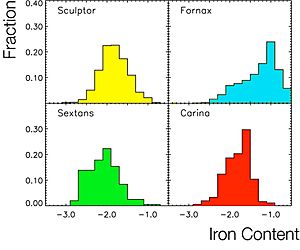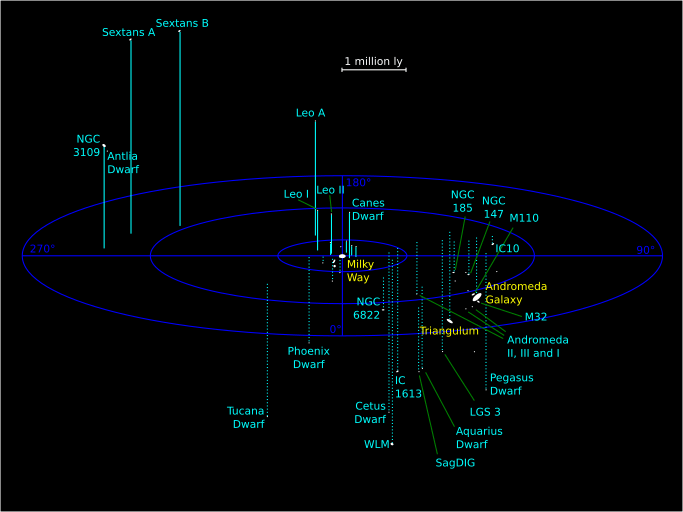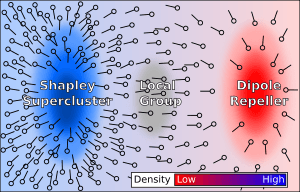Local Group facts for kids

The Local Group is like a cosmic neighborhood for galaxies! It's a cluster of galaxies, which means they are all held together by gravity. These galaxies are quite close to each other compared to other galaxies in the huge universe. Imagine it as a small town in a very big country. Our own Milky Way galaxy is a part of this amazing group!
The name "Local Group" was first used by a famous astronomer named Edwin Hubble in 1936.
Contents
How Big is Our Galactic Neighborhood?
The Local Group has over 50 galaxies, including many smaller ones called dwarf galaxies. All these galaxies together have a huge total mass, about 1.29 trillion times the mass of our Sun!
The galaxies in the Local Group spread out over a distance of 10 million light-years. That's a super long way! A light-year is how far light travels in one whole year. Light moves incredibly fast, but it would still take a super-fast spaceship many, many years to cross the Local Group.
Our Local Group is actually part of an even bigger collection of galaxies called the Virgo Supercluster.
Who Are the Main Galaxies in the Local Group?
The Local Group is a busy place with many galaxies of different shapes and sizes. But some galaxies are much bigger and brighter than others. Let's meet the superstars:
- The Milky Way: This is our home galaxy! It's a beautiful spiral galaxy with hundreds of billions of stars, including our Sun. It stretches about 100,000 light-years across.
- Andromeda (M31): This is the largest galaxy in the Local Group. It's also a spiral galaxy, even bigger and brighter than the Milky Way! Andromeda is about 2.5 million light-years away from us. On a clear night, you can even see it with your bare eyes as a fuzzy patch of light.
- Triangulum (M33): This is a smaller spiral galaxy, like a "little brother" to the Milky Way and Andromeda. It's about 3 million light-years away from us.
These three are the biggest and brightest, but there are many, many more!
What About the Smaller Galaxies?
Besides the giant spiral galaxies, the Local Group is home to many smaller galaxies called dwarf galaxies. These are much smaller than the Milky Way, Andromeda, and Triangulum. They often have irregular shapes and contain far fewer stars. Think of them as the smaller houses and apartments around the bigger buildings.
Some examples of dwarf galaxies in the Local Group include:
- Large Magellanic Cloud (LMC): This is a satellite galaxy of the Milky Way. "Satellite" means it orbits our galaxy. It's a fairly large dwarf galaxy and can be seen in the Southern Hemisphere.
- Small Magellanic Cloud (SMC): Another satellite galaxy of the Milky Way, also visible in the Southern Hemisphere. It's smaller than the LMC.
- Canis Major Dwarf Galaxy: This is actually the closest galaxy to the Milky Way! It's partly hidden behind the bright stars of our own galaxy.
Astronomers keep finding new dwarf galaxies! They are important because they help us understand how galaxies form and change over time.
How Do We Study the Local Group?
Astronomers use powerful telescopes on Earth and in space to study the Local Group. These telescopes let us see the light from these distant galaxies. By studying that light, we can learn many things about them. We can find out how far away they are, how fast they are moving, and what they are made of.
What's the Future of Our Galactic Neighborhood?
The galaxies in the Local Group are not standing still! They are all moving, pulled by each other's gravity.
In about 4.5 billion years, the Milky Way and Andromeda are expected to crash into each other! But don't worry, it won't be a big explosion like billiard balls. Galaxies are mostly empty space. Instead, it will be a slow, grand merger. They will eventually form one single, giant elliptical galaxy. This future giant galaxy is sometimes called "Milkomeda."
The Local Group is a super interesting area for astronomers to study. By looking closely at the galaxies in our cosmic backyard, we learn about how all galaxies in the universe form and change. There's still so much to discover!
Explore the Local Group (Map)

Related Topics
See also
 In Spanish: Grupo Local para niños
In Spanish: Grupo Local para niños



